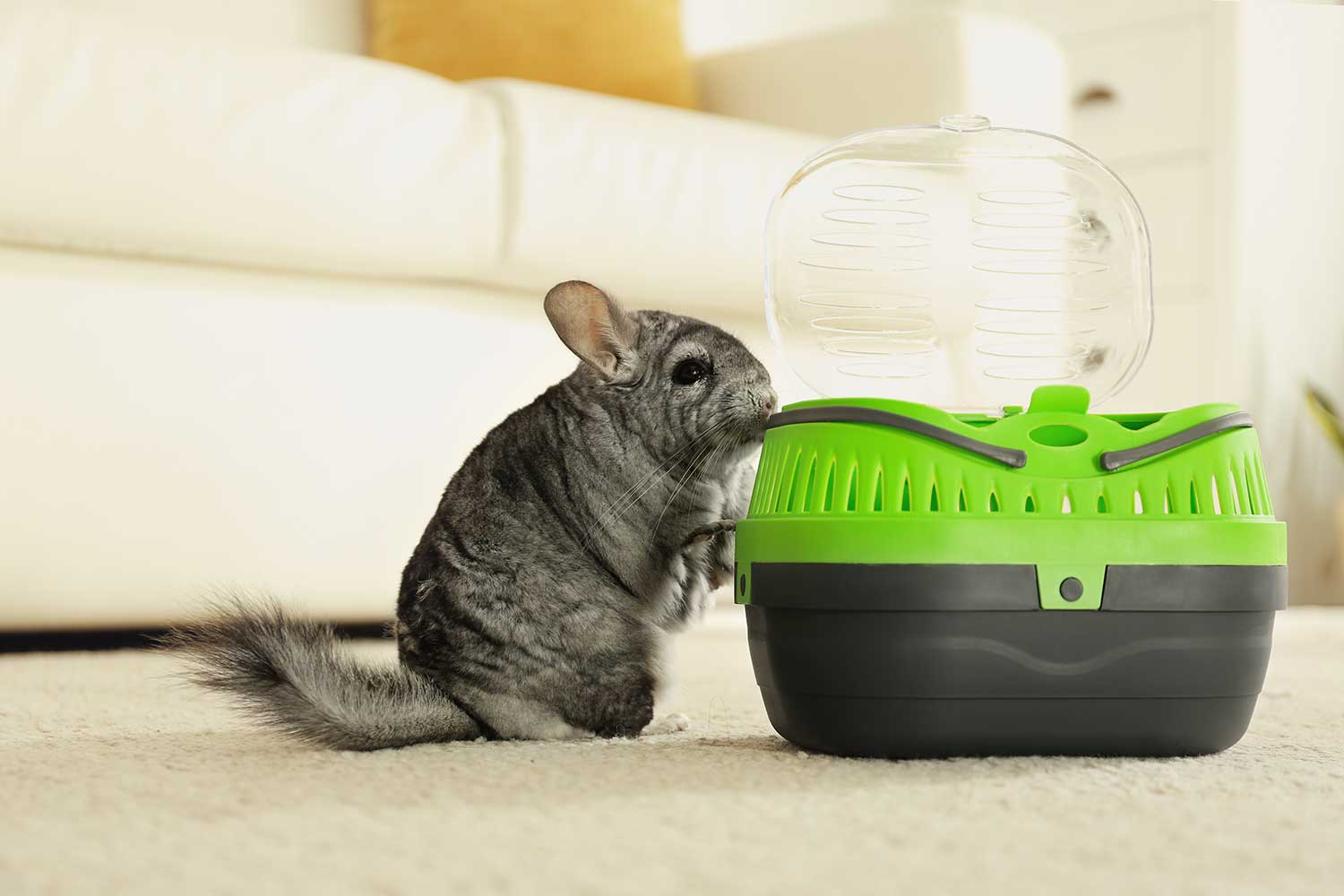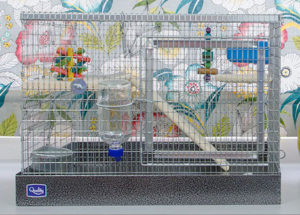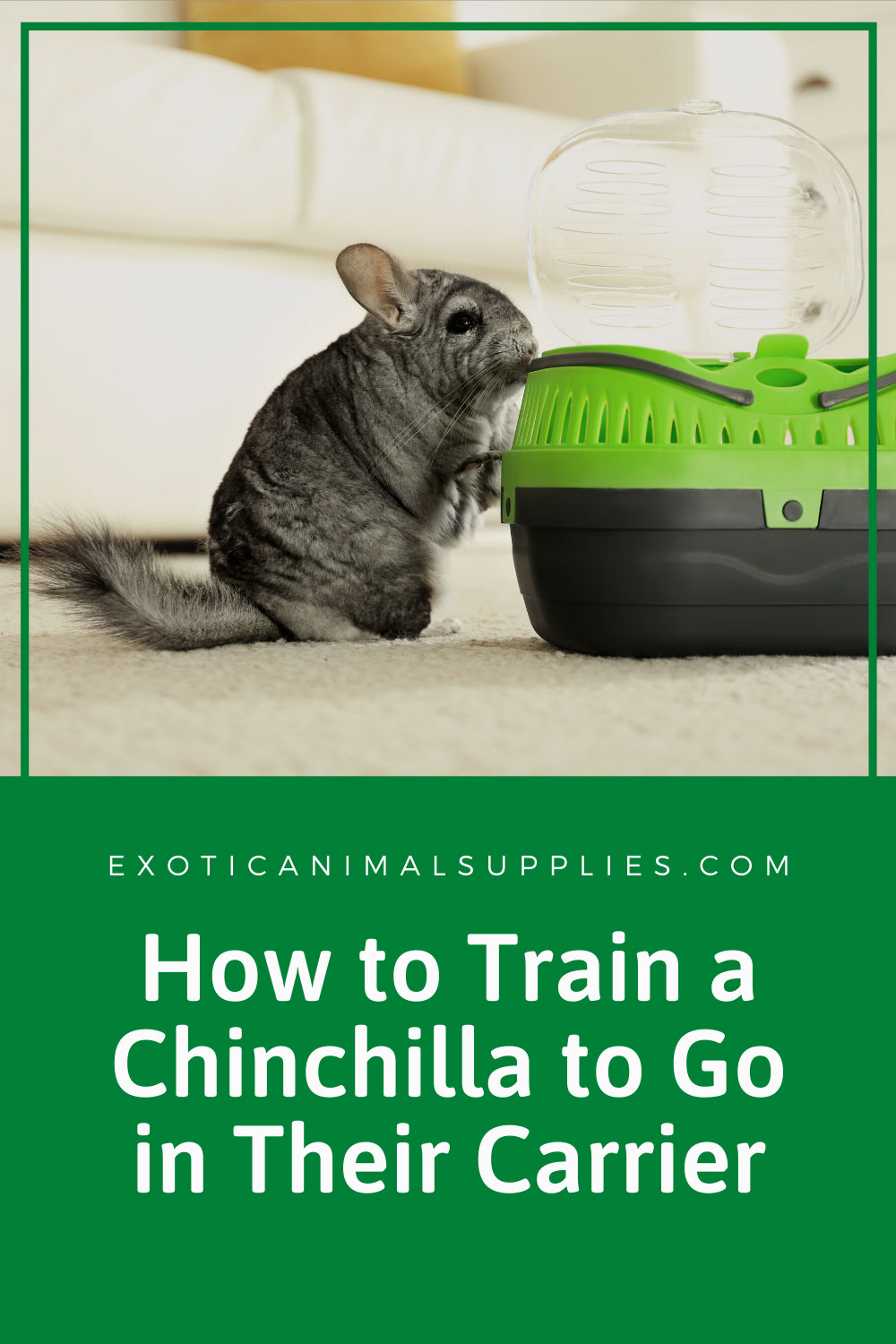
If you need to transport your chinchilla, whether it be going to show, to the exotic pet vet, or because you’re moving houses, you need a carrier to transport your chinchilla. In certain situations, you may even need a temporary travel cage to house your chinchilla at a hotel or a friend’s house. In this article, we look at the different types of chinchilla carriers and cages so you can select the best one for your pet.
Contents
Chinchilla Carriers vs. Travel Cages
It’s important to understand the different situations where you would use a carrier or a travel cage. Chinchilla carriers are used to transport the chin. This is what you would use if you were driving your chinchilla somewhere or flying on an airplane. This space should be as small as possible to prevent injury to your chinchilla in case of sudden stops.
A travel cage would be for your chinchilla to stay in if they’re away from their cage for an extended period of time. This cage is not as big as their normal cage but gives them enough space to move around and get a little exercise. These are good for situations where chinchillas will be sleeping away from home (like at a hotel or a friend’s house) or away from home for several hours (like a show). Many of these travel cages are collapsible to make them easier to transport and store.
All chinchilla owners should have a chinchilla safe carrier on hand. If your chinchilla has an emergency and needs to go to the vet, you will need a carrier. If you need to evacuate your home because of an emergency like a hurricane, flood, wildfire, or another event, you will probably need both a carrier and a travel cage. I recommend having both on hand if you live in an area where these types of emergencies are common.
Best Chinchilla Carriers
A few things to keep in mind when you’re looking at chinchilla carriers:
- They should be large enough that the chinchilla can move around some, but not too large that they can jump freely or be injured. Look for small pet or cat carriers.
- The carrier needs to be well ventilated. This is harder to accomplish with some fabric carriers, but there should be ventilation on at least 3 sides (all 4 sides and the top is best). This is to keep your chinchilla from overheating while they’re in the carrier.
- It should not be made of a material the chinchilla can easily chew through. Hard plastic carriers are the best, with wire ventilation.
- It should be easy to carry. It will make traveling easier for you and less scary for your furbaby.
Note: If you are planning on flying with your chinchilla, make sure you communicate with the airline early and directly about your plans. Many airlines will not let you fly with chinchillas and others will require you to check the chinchilla as cargo (which means they will be put under the plane with the baggage). Flying with a chinchilla as cargo is not recommended. There are some airlines that will allow you to fly with the chinchilla in the cabin if you have them designated as a service animal by a vet. The airlines will let you know what you need to do. Once you verify you can fly with your chinchilla, double-check with the airline that you have an approved carrier so your chinchilla can go under the seat in front of you. We do not claim that any of the below carriers are airline approved. These are just our recommendations for general car travel.
Midwest Chinchilla Carrier
Meant for small pets, and smaller cats and dogs, this carrier is a great option for traveling with your pet chinchilla. What sets this carrier apart from other options is that it features ventilation on all sizes and the top to keep your chinchilla cool. Made from hard plastic with metal bars, it’s good for short-term travel with your chin.
There is enough space under the handle to slide a seatbelt through to secure your pet in the backseat. For a single chinchilla, I would recommend the 19″ “Toy Dog” size. Quick assembly, no tools required.
Colors: Green, Blue, Red
Dimensions: Option 1: 17.91″L x 11.5″W x 12″H, Option 2: 20.7″L x 13.22″W x 14.09″H, Option 3: 23.55″L x 15.04″W x 15.56″H
Petmate Compass Kennel for Small Pets
The Compass Kennel is a sturdy, traditional style pet carrier. It features ventilation on all four sides to keep your chin from overheating and is made from sturdy plastic. The quick latch 2-way door can open in either direction or be removed completely to easily let your chinchilla in or out.
These kennels are normally made for dogs, so you really only need the smallest size. I recommend the “up to 10 lbs” version for chinchillas. Easy assembly, no tools required.
Available Colors: pearl white/black
Dimensions: 19 x 12.7 x 11.5 inches
Atlas 2 Door Pet Carrier for Chinchillas and Small Animals
This hard-sided carrier is a great options for traveling with chinchillas. Made from hard plastic, it features two doors of steel wire on the front and the top, giving you multiple options to put your chinchilla inside. Top doors are very convenient for reluctant chinchillas who hate going to the vet, since it’s easier to lift your chin out of the carrier. This design provides ventilation on all four sides and the top of the carrier.
Like most carriers of this design, the top clips to the bottom, but this version features extra safety screws that add reinforcement. This carrier is great for car trips or driving to the vet. Easy, no tool assembly required. The 19″ size is perfect for chinchillas.
Colors: Light purple/white, light blue/white
Dimensions: Small: 18.75L x 13W x 11.75H, Large: 23.125L x 14.5W x 13.5H
Best Chinchilla Travel Cages
Chinchilla Collapsible Travel Cage
 This is the travel cage we see most recommended by breeders and people who show chinchillas. Made by Quality Cage Crafters, which specializes in chinchilla cages and accessories, the cage comes with a ramp, shelf, and ledge. Your chin will feel right at home in this temporary cage.
This is the travel cage we see most recommended by breeders and people who show chinchillas. Made by Quality Cage Crafters, which specializes in chinchilla cages and accessories, the cage comes with a ramp, shelf, and ledge. Your chin will feel right at home in this temporary cage.
The cage is fully metal, with an attachable powder coat metal tray. You can easily add their carrier handle to make the cage even more portable. The cage is collapsible for easy storage and transportation.
Dimensions: 24″w x 18″d x 18″h
Folding Wire Dog Crate
This highly portable and foldable crate is meant for dogs, but it’s perfect for traveling with pet chinchillas as well. Though it will need to be outfitted with chinchilla accessories and shelves, it’s the right size to make a travel home for your chin. The all-metal wires and rust-resistant pan will keep your chin from chewing their way out.
The crate has two doors, which means it’s accessible from the front and the side. The crate folds down and sets up in less than a minute, and comes with a carrying handle (looks like a briefcase when it’s folded).
Dimensions: 30″ Long x 18″ Wide x 22″ High
Travel Essentials for Chinchillas
When you’re traveling with your chinchilla, you can’t just toss them in a carrier and go. You need to have essential supplies and some little “luxuries” to keep your pet chinchilla happy and calm while traveling. What you’ll need to provide varies on whether it’s a quick trip (like going to the vet) or a longer ride.
Because a chinchilla gets stressed easily, you want to make sure they feel safe and secure while they’re traveling to help reduce stress. If you’re traveling during the day, they’ll often just sleep during the trip so you only need to make sure they’re comfortable.
Chinchilla Supplies for Quick Trips
 You want to make the cage comfortable, so you should include some sort of bedding in the bottom of the carrier or a fleece blanket to give them a soft surface to rest on.
You want to make the cage comfortable, so you should include some sort of bedding in the bottom of the carrier or a fleece blanket to give them a soft surface to rest on.
If it’s warm weather while you’re traveling and there’s enough room in the carrier, you may also want to include a chinchiller to help keep them cool. You must travel in an air-conditioned vehicle during warm weather.
Another item that’s good to have on hand is a light sheet or a blanket to drape over the chinchilla carrier. This can be helpful in situations where your pet will be around other animals (like in a vet waiting room) or other chaotic spaces. You can cover the carrier and give them a safe zone away from the noise. These blankets are also good to keep warmth in during colder months.
Chinchilla Supplies for Long Trips
In addition to the recommended items for short trips, you’ll want to include these items for longer trips.
You’ll want to make sure to have water and food available for your chinchilla. They may be too stressed to eat or drink, but you want to have pellets, hay, and a water bottle on hand. Your pet probably won’t want them while the car is in motion, but you should provide edibles while at rest stops and when they reach their final destination. Water bottles also tend to drip if jostled around, so only offer water periodically.
If the carrier is big enough, you should provide some sort of hiding box so they have a safe space to go to if they get overstressed. This is a big necessity for their travel cage if they’re staying somewhere new for any period of time.
You can also bring some toys and wood for them to gnaw on.
Getting Your Chinchilla into their Carrier
This can be one of the biggest challenges, especially for new chinchilla owners. Your chinchilla may not be totally comfortable and bonded to you yet or may not like being picked up or held. That makes it extremely tricky to get them in their carrier to go to the vet or in the case of an emergency evacuation.
If you can easily grab your chinchilla by hand and scoop them up to put them in the travel carrier, that is the best way. However, I have two tricks I recommend for a worse case scenario where you need to get your chinchilla in their carrier ASAP and your chin won’t cooperate:
Grab them by the base of their tail
This is something you should do with caution. Generally, you do not want to grab a chinchilla by their tail because it can break off if you grab it by the tip. However, if you can grab it at the base, you should be able to get a firm enough grip to then scoop them up and hold them against your chest. If you are not confident that you can do this or haven’t done this before, I do not recommend doing it in an emergency situation where you are already stressed.
Trap them in their dust bath
This is the most foolproof way to get your chinchilla in a carrier in an emergency situation. Unfortunately it only works if you use a dust bath house or other container with a small opening.
Place the dust bath in their cage and wait until your chinchilla goes inside. Put your hand over the opening (or use a towel if your chinchilla gets bitey when they’re scared). Quickly but carefully move the dust bath house until the opening is against the opening of the carrier. Remove your hand and your chin will jump into the carrier.
Note: this is only to be used in emergency situations and not used as a regular way to get your chin into a carrier. It will stress your chinchilla out and after a few times, they will become distrustful of their dust bath.
The best way to get your chinchilla into a travel carrier is by training them to go in themselves.
Training a chinchilla to go in a carrier

This takes a lot of time and patience and it usually helps if you’ve already trained your chinchilla with basic commands like “Come.”
The first thing you want to do is allow your chinchilla to become comfortable with their carrier. During their playtime, set the carrier out in their exercise pen or play space and let them investigate it. Since chins are naturally curious, they will eventually come over to check it out. Let them sniff it, climb on it, and just generally become comfortable with it.
If they go inside, immediately give them auditory praise (like clicking a clicker or saying “Good.”) and give them a treat. This will help them associate going in the crate with the positive experience of receiving their favorite treat.
The next step is to train them to go into the crate on command. If your chinchilla is especially quick to catch on, they may run to the carrier immediately as soon as you put it on the floor and go inside expecting their treat. If not, you will need to spend some time teaching them commands and then teaching a specific command to go into the carrier. Learn more about training your pet chinchilla with treats and watch a video on how to train your chin to go in their carrier.
Make sure you have everything your chin needs by checking our new owner checklist for chinchillas.




